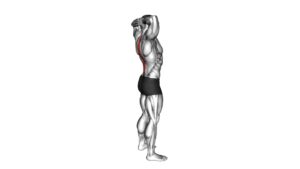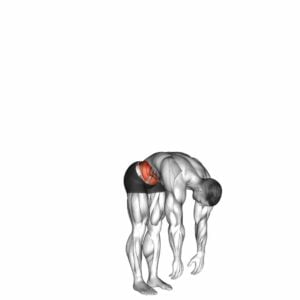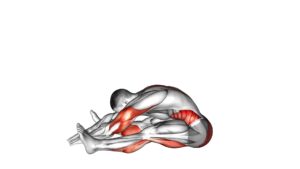Spine Twist – Video Exercise Guide & Tips

Get ready to twist and strengthen your spine with the Spine Twist exercise! In this video exercise guide, you'll learn the proper technique and form for this effective workout.
Watch This Exercise Video
With the help of modifications and progressions, you can tailor the exercise to your fitness level. Avoid common mistakes and maximize the benefits of the Spine Twist.
So grab your mat and get ready to give your spine a healthy twist!
Key Takeaways
- Spine Twist improves flexibility and mobility in the spine.
- Proper technique for Spine Twist includes maintaining a long and tall spine, rotating from the waist, and keeping the jaw relaxed.
- It is important to engage core muscles, maintain proper form, and avoid strain on the body during the exercise.
- Modifications for beginners include using support between the knees and starting with smaller movements, while advanced options for experts include adding resistance and performing on unstable surfaces.
Benefits of the Spine Twist
One key benefit of the Spine Twist is that it helps improve flexibility and mobility in your spine. The Spine Twist is a series of exercises that target the muscles in your back and promote spinal mobility. By incorporating different variations of the Spine Twist into your routine, you can enhance the range of motion in your spine and increase your overall flexibility.
There are several spine twist variations that you can try to improve spinal mobility. One variation is the seated twist, where you sit on the floor with your legs extended in front of you and twist your torso from side to side. Another variation is the supine twist, where you lie on your back and bring your knees to your chest before twisting them to one side. These variations target different areas of your spine and provide a comprehensive workout for your back muscles.
Incorporating spine twist variations into your workout routine can have numerous benefits. Not only do they improve flexibility and mobility in your spine, but they also help relieve tension and tightness in your back muscles. By performing these spinal mobility exercises regularly, you can maintain a healthy and flexible spine, which can contribute to better posture and overall well-being.
Proper Technique and Form
To perform the Spine Twist with proper technique and form, focus on engaging your core muscles and maintaining a tall, upright posture throughout the exercise. This will ensure that you get the maximum benefit from the exercise and avoid any potential injuries.
One common misconception is that the Spine Twist is all about twisting your spine as far as possible. However, it's important to remember that the spine should only rotate as far as your body allows without straining or causing discomfort. Trying to twist too far can lead to overstretching or even spraining the muscles and ligaments in your back.
Proper alignment is crucial during the Spine Twist. Make sure that your hips and shoulders are squared to the front, and that your spine is lengthened and straight. Avoid slouching or rounding your back, as this can put unnecessary strain on your spine.
Engaging your core muscles is key to maintaining stability and control during the Spine Twist. Imagine pulling your belly button towards your spine to activate your deep abdominal muscles. This will help to support your back and prevent any excessive twisting or strain.
Remember, it's always important to listen to your body and modify the exercise as needed. If you experience any pain or discomfort, stop the exercise and consult with a fitness professional or healthcare provider.
Equipment Needed for the Exercise
To perform the Spine Twist exercise, you'll need a mat or a soft surface to lie on. This will provide cushioning and support for your body as you perform the exercise.
In addition to a mat, there are a few other pieces of equipment that can enhance your experience and make the exercise more effective.
Here are some equipment options that you may consider using:
- Resistance bands: These can be used to add resistance to the exercise, making it more challenging and engaging your muscles even more.
- Pilates ring: Also known as a magic circle, this versatile piece of equipment can be used to add resistance and deepen the stretch during the Spine Twist exercise.
- Yoga block: Placing a yoga block between your knees or thighs can help to engage your inner thigh muscles and improve your stability during the exercise.
These equipment options aren't required for beginners, but they can provide additional support and challenge as you progress in your practice.
Remember to start with variations for beginners and gradually increase the intensity as you become more comfortable with the exercise.
Modifications and Progressions
Now let's explore modifications and progressions for the Spine Twist exercise.
If you're just starting out, there are simplified variations available that cater to beginners.
On the other hand, for those who are more experienced, advanced options are provided to challenge and push your limits.
Simplified Variations for Beginners
Start with one basic modification of the Spine Twist exercise to make it more accessible for beginners. Instead of sitting with your legs straight and together, you can bend your knees and place your feet flat on the ground. This modification helps to reduce strain on the lower back and makes it easier to maintain balance during the exercise.
Here are some additional beginner modifications for the Spine Twist:
- Use a towel or yoga block between your knees to provide support and stability.
- Start with smaller movements, gradually increasing the range of motion as you build strength and flexibility.
- Focus on engaging your core muscles throughout the exercise to maintain stability and control.
Advanced Options for Experts
If you're an expert looking to take your Spine Twist exercise to the next level, try incorporating advanced modifications and progressions. These advanced variations can help challenge your core muscles even further and enhance the overall effectiveness of the exercise.
One advanced modification you can try is adding resistance by using a resistance band or weights while performing the Spine Twist. This increases the intensity and engages more muscles in your upper body.
Another option is to perform the Spine Twist on an unstable surface, such as a stability ball or a foam roller. This requires additional stabilization and strengthens your core even more.
By incorporating these advanced modifications, you can continue to challenge yourself and see further improvements in your core strength and stability.
Now, let's explore the benefits of modifying exercises.
Benefits of Modifying Exercises
To enhance the overall effectiveness of the Spine Twist exercise, incorporating modifications and progressions can provide numerous benefits that challenge your core muscles even further. By modifying the exercise, you can tailor it to your fitness level and gradually increase the intensity as you progress. This not only keeps your workouts interesting and engaging but also helps prevent plateauing and promotes continued improvement.
Additionally, modifying exercises can help you avoid injuries by allowing you to maintain the proper form and technique. It ensures that you're performing the exercise in a safe and effective manner, minimizing the risk of strain or overexertion. Remember, always prioritize the importance of proper form and follow safety precautions to maximize the benefits of your workout.
Common Mistakes to Avoid
To prevent common mistakes while performing the Spine Twist exercise, focus on maintaining proper form and avoiding these errors.
One common mistake is using momentum instead of engaging your core muscles to perform the movement. This can lead to a less effective workout and increase the risk of injury.
Another mistake to avoid is rounding your back or shoulders during the twist. This can strain your spine and put unnecessary stress on your neck and shoulders. To maintain proper technique, keep your spine long and tall, and imagine rotating from your waist rather than your shoulders.
It's also important to avoid gripping or tensing your jaw, as this can create tension in your neck and shoulders. Instead, keep your jaw relaxed and your breath steady throughout the exercise.
Lastly, make sure to perform the Spine Twist on a stable and supportive surface to prevent any undue strain on your body.
Sample Spine Twist Workout Routine
To begin your Spine Twist workout routine, start by lying on your back with your knees bent and feet flat on the floor. This exercise is great for improving spinal mobility and strengthening the muscles of your core and back.
Here is a sample workout routine to get you started:
- Start with 10 repetitions of the basic Spine Twist exercise. Remember to keep your shoulders relaxed and your core engaged as you twist your spine from side to side.
- Next, incorporate some spine twist variations to target different areas of your back and core. Try the Single Leg Spine Twist, where you extend one leg straight out while twisting your spine. This variation challenges your balance and works your obliques.
- Finish your routine with the Seated Spinal Twist. Sit on the edge of a chair with your feet flat on the floor, and twist your upper body to one side. This exercise stretches your spine and helps to relieve tension in your lower back.
Frequently Asked Questions
How Often Should I Perform the Spine Twist Exercise?
To get the most out of the spine twist exercise, it's important to know how often to perform it. The frequency of spine twist exercises depends on your fitness goals and current fitness level.
It's generally recommended to perform this exercise 2-3 times a week to reap the benefits of improved spinal mobility, increased core strength, and better posture. However, it's always best to consult with a fitness professional to determine the most appropriate frequency for your specific needs.
Can the Spine Twist Help Improve My Posture?
The spine twist exercise can indeed help improve your posture. By engaging the muscles in your core and back, it can strengthen and lengthen the spine, promoting proper alignment.
Incorporating spine twist benefits into your regular exercise routine can help counteract the effects of prolonged sitting or poor posture. Remember to maintain proper spine twist technique, keeping your back straight and your shoulders relaxed.
This exercise can be a valuable addition to your posture improvement regimen.
Is the Spine Twist Suitable for Individuals With Lower Back Pain?
The spine twist is a popular exercise that can be beneficial for individuals with lower back pain. By engaging the core muscles and mobilizing the spine, it can help alleviate discomfort and improve flexibility.
However, it's important to modify the exercise to suit your needs. Avoid any movements that cause pain or discomfort, and consult with a healthcare professional or a certified fitness instructor for guidance on proper form and modifications.
Can the Spine Twist Exercise Help With Flexibility?
The spine twist exercise can help improve your flexibility. By engaging your core and twisting your spine, this exercise stretches and strengthens the muscles in your back and abdomen.
It also increases mobility in your spine, allowing for greater flexibility and range of motion. There are various variations of the spine twist exercise that can target different areas of your body and provide additional benefits.
Are There Any Contraindications or Precautions to Consider Before Attempting the Spine Twist Exercise?
Before attempting the spine twist exercise, it's important to be aware of any contraindications or precautions.
It's crucial to consult with a healthcare professional if you have any pre-existing conditions, such as back injuries, osteoporosis, or herniated discs, as these might be contraindications for this exercise.
Additionally, if you experience pain or discomfort during the exercise, it's recommended to stop and seek guidance from a qualified instructor or healthcare professional.
Conclusion
In conclusion, the spine twist exercise is a beneficial movement for improving spinal mobility and strengthening the core muscles.
By following proper technique and form, using the necessary equipment, and making modifications or progressions as needed, you can maximize the benefits of this exercise.
Remember to avoid common mistakes and try incorporating the spine twist into your workout routine for a well-rounded and effective fitness regimen.

Author
Years ago, the spark of my life’s passion ignited in my mind the moment I stepped into the local gym for the first time. The inaugural bead of perspiration, the initial endeavor, the very first surge of endorphins, and a sense of pride that washed over me post-workout marked the beginning of my deep-seated interest in strength sports, fitness, and sports nutrition. This very curiosity blossomed rapidly into a profound fascination, propelling me to earn a Master’s degree in Physical Education from the Academy of Physical Education in Krakow, followed by a Sports Manager diploma from the Jagiellonian University. My journey of growth led me to gain more specialized qualifications, such as being a certified personal trainer with a focus on sports dietetics, a lifeguard, and an instructor for wellness and corrective gymnastics. Theoretical knowledge paired seamlessly with practical experience, reinforcing my belief that the transformation of individuals under my guidance was also a reflection of my personal growth. This belief holds true even today. Each day, I strive to push the boundaries and explore new realms. These realms gently elevate me to greater heights. The unique combination of passion for my field and the continuous quest for growth fuels my drive to break new ground.



